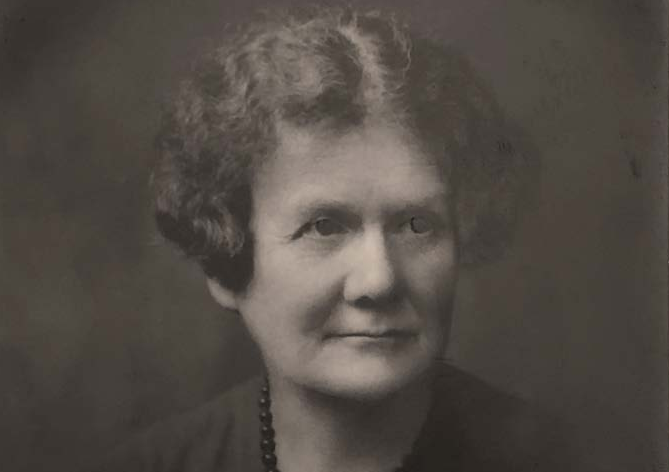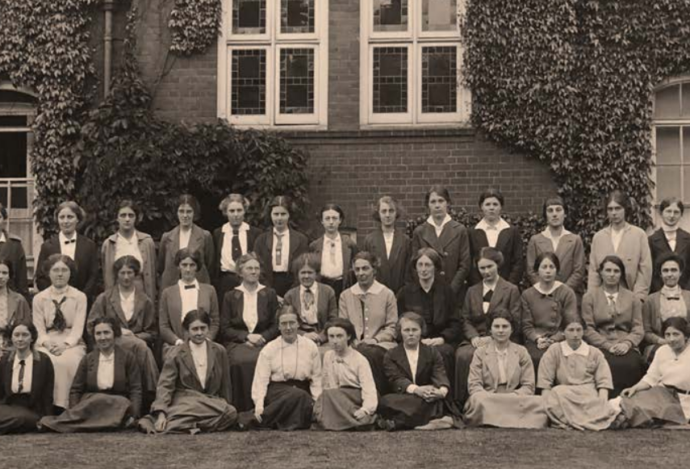This article was originally published in the Hughes Magazine and is shared again to mark 138 years since the inauguration of the College at its founding Committee Meeting at 3 Newnham Terrace in Cambridge on 9th May 1885.
Dr Jean Lambert, Honorary Archivist and Life Fellow, reflects on the major changes to our college after the upheavals of the First World War and the subsequent flu pandemic and economic downturn. She explores how Hughes Hall responded to the national challenges and in particular the tremendous and growing demand for education.
During the 1914–1918 World War and its immediate aftermath, the college continued to admit female graduates to train for the teaching profession, albeit in smaller numbers. Remarkably, despite blackouts, curfews and the occasional observation balloon, the atmosphere on the Wollaston site remained buoyant, staff and students staying positive throughout. Their optimistic mood
can almost certainly be attributed to the communal desire to contribute practically to the war effort.
Temporarily, a good deal of time and appropriated college space were devoted to fundraising activities, including public performances, and making up parcels of provisions for dispatch to the frontline. Trainees also gained valuable additional teaching experience by standing in for masters in local secondary schools and, further afield, alumnae members filled vacant positions in boys’ grammar schools.
A rebuilding strategy
By 1921–1922, when England was beginning to emerge from crises caused by the flu pandemic (1918– 1920) and the subsequent economic downturn, the college Principal, Miss Wood, was relieved to announce a return to pre-war admission levels. Interestingly, however, although equally devastating, the effect of global flu on college life is not on record, all focus from 1919 being on
a rebuilding strategy. The upturn in entrant numbers can be attributed to a variety of likely causes relating to post-war outcomes, significant among them being the demographic shift.
According to the 1921 census, for the first time since 1801, females outnumbered males: unsurprising after the slaughter of the war. Consequently there was a great need for women in the workforce. Women had gained war-work experience, had won the vote in August 1920, and were enjoying more independence. However, despite these advances, they still could not take a degree at Cambridge.
In addition, in the academic year 1920–1921, the college authorities clarified the status and purpose of the college by adding ‘Post-graduate’ to its title. This change was possibly reflected in the ‘quality’ of entrants with an increased graduate intake and the number of universities represented – 15 in 1921 and 17 in 1922, including an institution in India. Students benefited from the availability of more single rooms on the Wollaston site and the conversion of the gymnasium into the college’s first common room, more recently known as the MCR Bar and Clubroom.
Advancing on a rising tide
A further factor relating to the growth in admissions was the tremendous demand for education, a pre-war phenomenon ‘quickened’ by war. In one of her addresses to students and alumnae for the Bedford College appeal, Miss Wood quotes Lord Robert Cecil. Speaking at Mansion House in October 1920, Cecil commented ‘Men and women are passionately anxious to be educated. What does it mean?’ He went on to say that, fundamentally, it is for equality, that people who are not educated or not so highly educated are rightly anxious that they shall not be put at any disadvantage with their fellows, and that, perhaps even more, individuals all over the country can no longer leave great parts of their lives to be managed by other people.
According to Miss Wood ‘this is the ideal that the educator has the power, if he will, to promote or defer’. She also acknowledges the widespread tendency towards depression and disillusionment following the war – characteristics of the mindset of the modernist era. Yet, she ends with an upbeat message: ‘education still seems to be advancing on a rising tide’.
In line with that tidal surge, the spirit that sustained the college’s community during and after the war was kept alive through student enterprise and endeavour. Apart from the usual clubs and societies – among them, the Christian Movement, Field Club, German Society and French Society – students entertained ‘old students’ and learned from them about college annals, enacted various plays, including Friar Bacon and Friar Bungay for freshers, and raised funds for Russian children and Save the Children. Students also continued to keep in touch with the ‘outside world’
through, for example, the League of Nations, the Industrial Christian Fellowship, the Socratics and CUMS.
A century later
Are we experiencing a similar rising tide in education following the COVID pandemic? Will we have our own equivalent Jazz Age and Roaring Twenties? In the current academic year, 2021–2022, we have seen admissions rise, partly but not wholly due to deferrals. We have welcomed new students with receptions and matriculation dinners and met second-year students in person for the first time, most of them seizing the opportunity to have their Cambridge freshers’ experience. We cannot know what it was like for students residing in college during World War One and its immediate aftermath, but we do know from the 2019 lockdown, when many of our students were dispersed across the globe, that a large percentage of our current students experienced difficulties as we adapted to a virtual university. Happily, the tide appears to be turning in 2022, confidence is returning and we are, once again, re-connecting collegially.
This article was originally published the Hughes Magazine, edition 34, available here: www.hughes.cam.ac.uk/academic/hughes-magazine.
10.5.23







